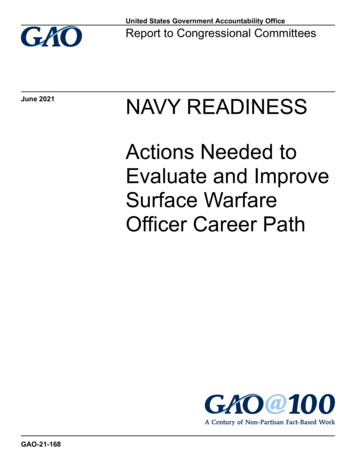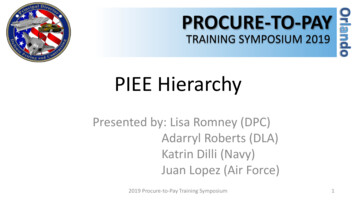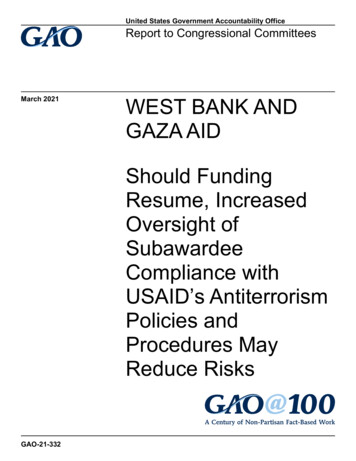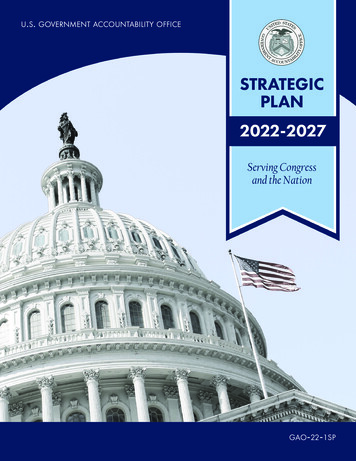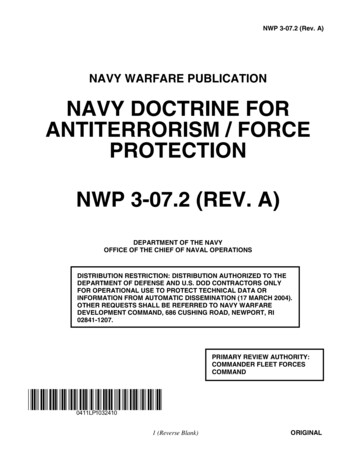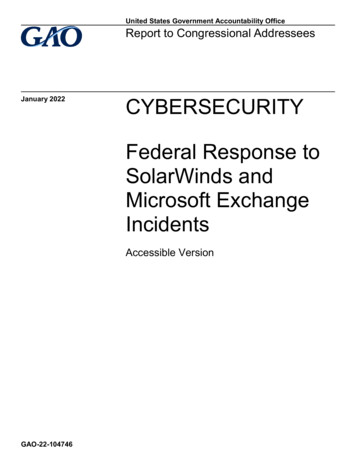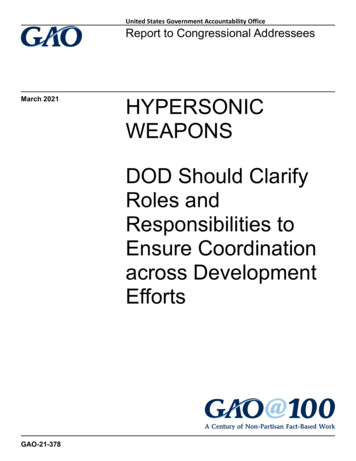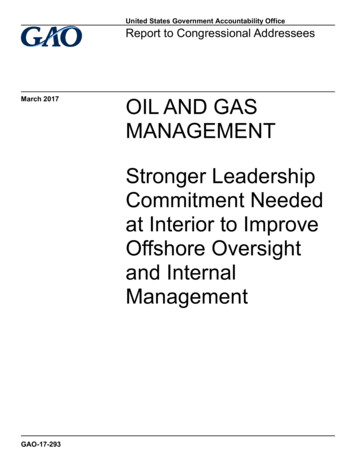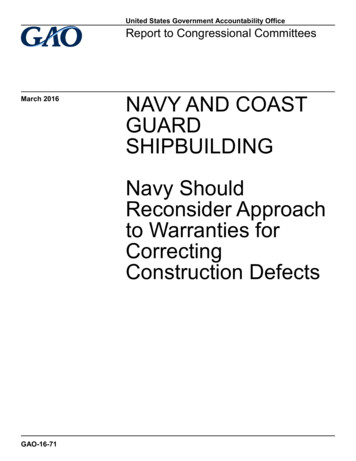
Transcription
United States Government Accountability OfficeReport to Congressional CommitteesMarch 2016NAVY AND COASTGUARDSHIPBUILDINGNavy ShouldReconsider Approachto Warranties forCorrectingConstruction DefectsGAO-16-71
March 2016NAVY AND COAST GUARD SHIPBUILDINGNavy Should Reconsider Approach to Warranties forCorrecting Construction DefectsHighlights of GAO-16-71, a report tocongressional committeesWhy GAO Did This StudyWhat GAO FoundThe U.S. government spends about 17 billion per year building ships tosupport national defense andhomeland security. Defects oftenbecome evident shortly after a ship isdelivered. Warranties and guaranteesare both mechanisms to fix defects forwhich shipbuilders are responsible.For five of the six Navy and Coast Guard ships GAO reviewed, guarantees didnot help improve cost or quality outcomes. While the type and terms of eachcontract determine financial responsibility for correcting defects, the government,in most of the cases GAO examined, paid shipbuilders to repair defects. For thefour ships with fixed-price incentive type contracts and guarantee clauses, thegovernment paid the shipbuilder 89 percent of the cost—including profit—tocorrect these problems. This means the Navy and Coast Guard paid theshipbuilder to build the ship as part of the construction contract, and then paidthe same shipbuilder again to repair the ship when defects were discovered afterdelivery—essentially rewarding the shipbuilder for delivering a ship that neededadditional work. Navy officials stated that this approach reduces the overall costof purchasing ships; however, the Navy has no analysis that proves their point. Incontrast, the warranty on another Coast Guard ship—the Fast Response Cutter(FRC)—improved cost and quality by requiring the shipbuilder to pay to repairdefects. The Coast Guard paid upfront for the warranty, which amounted to 41percent of the total defect correction costs. The figure below shows the amount,as a portion of the millions of dollars required to address defects, shipbuildersand the government paid to correct defects for the ships GAO reviewed and thedifference in defect-correction arrangements. Warranties give the government acontractual right to direct thecorrection of defects at thecontractor’s expense. Guarantees are Navy-specificcontractual mechanisms that providefor the correction of defects; butunlike warranties are not covered inthe FAR.The House report accompanying theNational Defense Authorization Act forFiscal Year 2015 included a provisionfor GAO to review warranties andguarantees in government shipbuildingprograms. This report assesses theextent to which (1) warranties andguarantees reduce the government’sexposure to additional costs and risksof poor quality and (2) how the Navyand Coast Guard use acquisitionregulations and guidance to implementwarranties and guarantees. GAOreviewed the Navy’s and CoastGuard’s guaranty or warranty practicesand policies and selected six casestudies, comprised of four Navyships—representing ships built in thelast five years—and two vessels theCoast Guard most recently purchased.What GAO RecommendsDOD with the Navy should take stepsto structure contracts so shipbuilderscannot earn profit for correcting defectsfor which they are responsible;determine whether a warranty isappropriate; and establish a guarantyobjective and guidance. DOD partiallyconcurred with the recommendationsand it plans to complete a study bySeptember 2016.View GAO-16-71. For more information,contact Michele Mackin at (202) 512-4841 ormackinm@gao.gov.Comparison of Costs Borne by Government and Shipbuilder for Correction of ShipbuilderResponsible Defects for the Six Ships GAO ReviewedAlthough the Federal Acquisition Regulation (FAR) and the Department ofDefense guidance instruct programs to, respectively, consider and document theuse of a warranty, the use of warranties is not mandatory, and the Navy does notconsider using them for ship contracts. In contrast, the Coast Guard’s FRCwarranty, as well as that planned for another upcoming ship class, fosters qualityperformance by following the FAR warranty provisions. The Navy may bemissing opportunities for savings by not considering use of warranties. Further,the Navy has no stated objective for its guarantees, and guidance for contractingofficers is minimal as to when or how to use a guaranty. While the FAR does notapply to guarantees, according to federal internal control standards, governmentprograms require objectives and guidance to ensure that they achieve thedesired results. Without a clear objective and guidance for using a guaranty andfor determining when a warranty is appropriate in shipbuilding, Navy contractingofficers do not have the information they need to make informed decisionsregarding which mechanism is in the best interest of the taxpayer.United States Government Accountability Office
ContentsLetter1BackgroundNavy’s Guaranty Mechanism Generally Has No Effect onImproving Cost and Quality Outcomes, in Contrast to FRC andCommercial WarrantiesObjective of the Guaranty Is Unclear and Navy Has Not FullyConsidered the Costs and Benefits of Using a Warranty perDOD GuidanceConclusionsRecommendations for Executive ActionAgency Comments and Our Evaluation23282929Appendix IObjectives, Scope, and Methodology33Appendix IIComments from the Department of Defense38Appendix IIIGAO Contact and Staff Acknowledgments41Related GAO Products41042TablesTable 1: Navy and Coast Guard Ships and Associated ShipyardsIncluded in This ReviewTable 2: Comparison of Warranty and Guaranty Provisions inNavy and Coast Guard ShipbuildingTable 3: Cost and Contract Characteristics of Navy and CoastGuard Ships In Our ReviewTable 4: How the Coast Guard Warranty and Navy GuarantyCompare with Federal Acquisition Regulation PrinciplesTable 5: Navy and Coast Guard Ships and Associated ShipyardsIncluded in This ReviewTable 6: Littoral Combat Ship 3 and LPD 25 Share LinesPage i3510263435GAO-16-71 Navy and Coast Guard Shipbuilding
FiguresFigure 1: Warranty or Guaranty Period in Terms of Navy andCoast Guard Shipbuilding ProcessFigure 2: Navy and Coast Guard Warranty or Guaranty ProcessFigure 3: Comparison of Costs Borne by Government andShipbuilder for Correction of Shipbuilder-ResponsibleDefects for the 6 Ships in GAO’s ReviewFigure 4: Comparison of Costs Borne by Government andShipbuilder for Correction of Shipbuilder-ResponsibleDefects for Four Ships with Fixed-Price Incentive TypeContractsFigure 5: Costs Borne by Government and Shipbuilder to CorrectDefects on the Fast Response Cutter 6 and DDG 11267111218This is a work of the U.S. government and is not subject to copyright protection in theUnited States. The published product may be reproduced and distributed in its entiretywithout further permission from GAO. However, because this work may containcopyrighted images or other material, permission from the copyright holder may benecessary if you wish to reproduce this material separately.Page iiGAO-16-71 Navy and Coast Guard Shipbuilding
Letter441 G St. N.W.Washington, DC 20548March 3, 2016Congressional CommitteesThe U.S. Navy and Coast Guard together spend approximately 17 billionper year building ships to provide the capabilities necessary to supportour national defense and homeland security. Given the difficult operatingenvironments and extended deployments for Navy and Coast Guardships, it is essential that they operate as intended. In the past 10 years,several cases of poor quality in Navy shipbuilding programs focusedattention on the construction quality of new ships. In many cases,deficiencies were attributable to problems with the basic elements ofshipbuilding, such as welding, installing propulsion and other mechanicalsystems, and assembling the electrical systems. We have reported oncost and quality problems facing Navy and Coast Guard shipbuildingprograms for many years. In May 2009, we compared Navy shipbuildingprograms with those of commercial shipbuilders and buyers and foundthat the Navy accepts higher risks of quality expectations not being metthan commercial buyers. 1 While Navy ships include complex andtechnically sophisticated systems, we noted, in November 2013,significant quality issues with the basic construction of some Navy ships.We found that some ship classes are routinely delivered with thousandsof outstanding defects with the hull, mechanical, and electrical systems,and made recommendations aimed at improving the Navy’s inspectionprocess. 2 Further, we recently found that, in some cases, Coast Guardships did not meet all key performance requirements due to shipbuildingdeficiencies. 3 The Navy and Coast Guard have taken action on some, butnot all of our recommendations.Following ship delivery, Navy and Coast Guard ships undergo severalactivities to prepare them for service within the fleet. The process of1GAO, Best Practices: High Levels of Knowledge at Key Points Differentiate CommercialShipbuilding from Navy Shipbuilding, GAO-09-322 (Washington, D.C.: May 13, 2009).2GAO, Navy Shipbuilding: Opportunities Exist to Improve Practices Affecting Quality,GAO-14-122 (Washington, D.C.: November 19, 2013).3GAO, Coast Guard Acquisitions: Better Information on Performance and FundingNeeded to Address Shortfalls, GAO-14-450 (Washington, D.C.: June 5, 2014).Page 1GAO-16-71 Navy and Coast Guard Shipbuilding
preparing ships for operations often includes a specified period of time inwhich the shipbuilder retains responsibility for correcting constructiondefects that arise on the ship after delivery—known as a warranty orguaranty period. Warranties and guarantees are contractualarrangements made with the shipbuilder regarding the correction ofdeficiencies discovered during this period, which generally lasts 8 to 12months after delivery for Navy and Coast Guard ships. The House Report113-446 on the National Defense Authorization Act for Fiscal Year 2015included a provision that GAO review warranties and guarantees ingovernment shipbuilding programs and how these mechanisms comparewith commercial shipbuilding. 4 This report assesses: (1) the extent towhich the Navy and Coast Guard’s guaranty or warranty mechanismsreduce the government’s exposure to additional costs and improve thequality of basic ship construction, if any, as compared to commercialshipbuilding; and (2) the extent to which the Navy and Coast Guard useavailable acquisition regulation and guidance in implementing warrantiesand guarantees in shipbuilding programs.To determine whether guaranty or warranty mechanisms reduce thegovernment’s exposure to additional costs and improve the quality ofthese ships, we reviewed the Navy and Coast Guard’s guaranty andwarranty policies and procedures. To further our understanding of thesepolicies and procedures, we reviewed six case study ships thatencompassed the majority of all ship classes recently built by the Navyand Coast Guard. Selected ships were delivered in the last 5 years. Mostof the contracts for the ships we reviewed were also used to purchaseother ships in the class. While we focused on six case studies, thecontracts and guaranty clauses we reviewed covered more than 20 ships.Further, based on our analyses and our discussions with Navycontracting officials, we believe our review is illustrative of Navyshipbuilding in general because every Navy shipbuilding contract uses asimilar guaranty clause. The six ships in our scope are shown in table 1;our scope includes most of the major Navy and Coast Guard shipyards.4H.R. Rep. No. 113-446, at 31 (2014).Page 2GAO-16-71 Navy and Coast Guard Shipbuilding
Table 1: Navy and Coast Guard Ships and Associated Shipyards Included in This ReviewShipyardLocationShip class (Ship)Austal USA (subcontractor to GeneralDynamics/Bath Iron Works)Mobile, AlabamaLittoral Combat Ship (LCS 4)General Dynamics/Bath Iron WorksBath, MaineArleigh Burke Class Guided Missile Destroyers(DDG 112)Bollinger ShipyardsLockport, LouisianaFast Response Cutter (FRC 6)Huntington Ingalls Industries ShipbuildingPascagoula, MississippiNational Security Cutter (NSC 4)Huntington Ingalls Industries ShipbuildingAvondale, LouisianaSan Antonio Class Amphibious Transport Dock(LPD 25)Marinette Marine Corporation (subcontractor toLockheed Martin)Marinette, WisconsinLittoral Combat Ship (LCS 3)Source: GAO. GAO-16-71We did not choose lead ships, because lead ships tend to be purchasedusing cost-reimbursement type contracts and usually have more anddifferent quality issues than the rest of the class. For each ship, wereviewed the guaranty or warranty contract language and other relevantclauses. We interviewed officials from the Navy and Coast Guard to gainan understanding of the guaranty or warranty process and compared ourobservations to the Federal Acquisition Regulation (FAR), Department ofDefense, and Department of Homeland Security guidance on guarantiesor warranties. We also compared ships with guarantees to governmentand commercial ships with warranties to determine the extent to whicheach mechanism improves ship quality. During visits to the shipyards, wemet officials from Navy and Coast Guard offices, such as the NavySupervisor of Shipbuilding, Conversion and Repair, Program ExecutiveOffices, and Coast Guard’s Project Residence Offices. We also met withCoast Guard contracting officials and contracting officers with the NavalSea Systems Command Contracting Directorate. These interviewsprovided information on how the Navy and Coast Guard use andimplement warranties and guarantees on newly constructed vessels. Wealso selected leading commercial buyers in the cruise, oil and gas, andcommercial shipping industries based on our previous work onshipbuilding best practices and conducted interviews with them regardinghow they contract for and execute warranties on ships of similar size andconstruction complexity as Navy and Coast Guard ships. 5 Our5GAO-09-322 and GAO-14-122.Page 3GAO-16-71 Navy and Coast Guard Shipbuilding
comparisons with commercial shipbuilding focused on basic shipconstruction because the work is similar to hull, mechanical and electricalwork completed on Navy and Coast Guard ships. Appendix I containsmore detail on our objectives, scope, and methodology.We conducted this performance audit from December 2014 to March2016 in accordance with generally accepted government auditingstandards. Those standards require that we plan and perform the audit toobtain sufficient, appropriate evidence for our findings and conclusionsbased on our audit objectives. We believe that the evidence obtainedprovides a reasonable basis for our findings and conclusions, based onour audit objectives.BackgroundWarranty and GuarantyMechanisms in Navy andCoast Guard ShipbuildingAcquiring a ship is a complex task and it is expected that, to a certaindegree, parts will break or welds may fail after a ship is delivered. Defectsrelated to the welding, fabrication, electrical, piping, and propulsionsystems on the ship that are the result of construction issues are typicallythe shipbuilder’s responsibility to fix as opposed to problems withsystems, such as weapon or complex information technology systems,which are purchased separately and, often, are the government’sresponsibility to correct. Warranties and guarantees are both mechanismsto address the correction of shipbuilder-responsible defects, but theydiffer in key ways. 6 Warranty provisions are outlined in the FAR, while theNavy sets forth its own guaranty provisions. In the case of the CoastGuard’s NSC, program officials told us they adopted the Navy’s guarantyprovisions; therefore we refer to the guaranty in this report as “the Navy’sguaranty” even though it also pertains to the NSC. Shipbuilding contracts6This report defines shipbuilder-responsible deficiencies as defects that occurredbetween ship delivery and final contract trials relating to aspects of the ship that theshipbuilder was responsible for delivering in satisfactory condition. Shipbuilder-responsibledeficiencies do not refer to financial responsibility for the costs of correction. Theshipbuilder may not be contractually obligated to fix all of the shipbuilder-responsibledefects, depending upon the contract terms. Defects discovered during ship construction-prior to delivery--are not included in this report but are addressed in our prior work; seeGAO-14-122 and GAO, Littoral Combat Ship: Navy Complied with Regulations inAccepting Two Lead Ships, but Quality Problems Persisted After Delivery, GAO-14-827(Washington, D.C.: Sept. 2014).Page 4GAO-16-71 Navy and Coast Guard Shipbuilding
can either use a warranty, a guaranty, or have no mechanism to addressdefects after delivery. Table 2 shows key elements of warranties andguarantees.Table 2: Comparison of Warranty and Guaranty Provisions in Navy and Coast Guard ShipbuildingWarrantyGuarantyDescriptionUsed to correct shipbuilder-responsible defectsafter delivery, usually at the shipbuilder’sexpense.Used to correct shipbuilder-responsible defects afterdelivery, but the responsibility for paying for thesecorrections varies upon contract terms.LengthWarranties are limited to a specific period oftime—typically 12 months.Guarantees are limited to a specific period of time,which generally ranges from 8 to 12 months.Liability limitationsTypically there are no cost limits on theshipbuilder’s financial responsibility forcorrecting defect claims.Uses a limitation of liability: the Navy includes a clausein its shipbuilding contracts that provides for theshipbuilder to be responsible for performing work tocorrect defects during the guaranty period up to acertain dollar threshold, but the shipbuilder is notnecessarily financially responsible for costs associatedwith the work. Once this threshold is reached, theshipbuilder is no longer contractually obligated toperform additional work to correct any additionaldefects, even if the ship is still within the guarantyperiod.Regulation andguidanceFederal Acquisition Regulation (FAR) subpart46.7 applies to warranties and provides thegovernment with a contractual right for thecorrection of defects, at the contractor’sexpense, notwithstanding other requirements ofthe contract regarding inspection andacceptance. The use of warranties is notmandatory and the FAR provides that thebenefits of a warranty must be commensuratewith the costs of the warranty to the government.The FAR also prescribes specific warrantycontract clauses when use of a warranty isappropriate that delineate the warranty period;the contractor’s warranty that supplies under thecontract will be free from defects; and thegovernment’s remedies, including the right torequire the contractor to repair defects.As guarantees are a Navy-specific contractingmechanism, the FAR does not apply.Navy ships typically use standard Navy-specificcontract clauses to comprise the guaranty mechanismincluding:(1) provisions in the inspection clause that, amongother things, provide the government with the right todirect correction of contractor-responsible defectsdiscovered during the guaranty period;(2) a guaranty clause that specifies the length of theguaranty period and that the shipbuilder can provide arepresentative (engineer) on board the vessel; and(3) a limitation of contractor’s liability for the correctionof defects as described above.Source: GAO analysis of the FAR, and Navy and Coast Guard data. GAO-16-71In Navy and Coast Guard shipbuilding, the warranty or guaranty perioddoes not overlap with ship deployments but typically occurs while thecrew is conducting tests and trials, and also performing any additionalconstruction (such as modifications), among other activities. Generally,the warranty or guaranty concludes with a ship’s final contract trials.Figure 1 highlights where the warranty or guaranty period resides in thetypical Navy and Coast Guard shipbuilding process.Page 5GAO-16-71 Navy and Coast Guard Shipbuilding
Figure 1: Warranty or Guaranty Period in Terms of Navy and Coast GuardShipbuilding ProcessWhile there are some nuances, the basic process of adjudicating awarranty or guaranty claim is the same for Navy and Coast Guardprograms. Figure 2 illustrates this process from the beginning—when asailor identifies a problem—through the end when the government utilizesthe warranty or guaranty to fix the defect.Page 6GAO-16-71 Navy and Coast Guard Shipbuilding
Figure 2: Navy and Coast Guard Warranty or Guaranty ProcessWhile the focus of this report is on warranties and guarantees, these arenot the only mechanisms intended to address shipbuilder-responsibledefects after delivery. In some cases, the Navy and Coast Guard insert alatent defect contract clause that provides for the correction ofdeficiencies that could not be discovered through reasonable inspectionwhen the ship was delivered. At final acceptance, prior to delivery to thePage 7GAO-16-71 Navy and Coast Guard Shipbuilding
fleet, the Navy and Coast Guard acknowledge that the ship conforms toall quality requirements, with the exception of latent defects, fraud, orgross mistakes amounting to fraud. Further, there is also a separateprocess for deficiencies pertaining to fraudulent work or parts, such ascounterfeit parts.Contract Types Used toPurchase Navy and CoastGuard ShipsThe Navy and Coast Guard use three primary contract types whenpurchasing ships—fixed-price type, incentive type, and costreimbursement type contracts. The first ships of a class, called lead ships,are often purchased with cost-reimbursement type contracts under whichthe government generally bears the risk of cost, schedule, or shipperformance problems. After the first few ships in a class, the Navy andCoast Guard generally use firm fixed-priced or fixed-price incentivecontracts because, as more ships are built, there is greater certaintyabout costs and performance.The following is a brief description of each contract type used to constructand repair the Navy and Coast Guard ships we reviewed: Firm Fixed-Price Contract—The government agrees to purchase aship for a set price. The shipbuilder bears the full responsibility forincreases in the cost of construction and earns a larger profit if actualcosts are below the contract price. When using this contract type, thecost of the warranty or guaranty can be included in the constructionprice of the vessel or priced separately for an agreed-upon amount. Inthe government, this contract type is usually used for matureshipbuilding efforts because it works best when the ship buyer andshipbuilder are confident in the cost of ship construction. Fixed-Price with Economic Price Adjustment (EPA) Contract—Similar to a firm fixed-price contract, the government and theshipbuilder agree to a set price for the ship, but in a fixed-price EPAcontract the government and shipbuilder agree to adjust, upward ordownward, the stated contract price upon occurrence of specifiedcontingencies, such as changes in costs of labor or material that theshipbuilder experiences during contract performance. For example,changes to the price of steel could be accounted for using thiscontract type. Fixed-Price Incentive Contract—Under fixed-price incentivecontracts, the government and the shipbuilder agree upon a targetcost, target profit, ceiling price, and a profit adjustment formulaPage 8GAO-16-71 Navy and Coast Guard Shipbuilding
referred to as a share line. The government and the shipbuilder share,in accordance with the share line, responsibility for cost increases ordecreases compared to the target cost, up to the ceiling price at whichpoint the shipbuilder is responsible for all remaining costs. Generally,the share line functions to decrease the shipbuilder’s profit as itsactual costs exceed the target cost. Likewise, the shipbuilder’s profitincreases when actual costs are less than the target cost for the ship.In an illustrative example, typical of ships in our review, if a contracthas a 70/30 share line and the shipbuilder’s actual costs were overthe target cost by 1 million; the government would pay 70 percent( 700,000) of the additional costs needed to complete the ship andthe shipbuilder would absorb 30 percent of the cost overrun( 300,000) as a reduction to profit. Cost-reimbursement Contract—Cost-reimbursement type contractsprovide for the government to pay the shipbuilder’s costs to the extentspecified in the contract and may include an additional fee (profit). Asopposed to a fixed price type contract that requires the shipbuilder todeliver a ship for the price specified in the contract, under a costreimbursement type contract the shipbuilder agrees to use its bestefforts to perform the work within the estimated costs. But thegovernment must reimburse the builder for its allowable costsregardless of whether the work is complete. These contracts can alsoinclude a guaranty clause. 7 In the case of the Coast Guard’s NSC, thefirst three ships were built using cost-reimbursement type contractswhile the remaining five are being built with fixed-price incentivecontracts. After ship delivery, the Navy may award separate costreimbursement type contracts to complete post-delivery activities,such as installing weapon systems and repairing defects.Table 3 shows the contract and vessel type for each Navy and CoastGuard ship we reviewed. As discussed earlier, we selected ships thatwere constructed after at least one other ship in the class.7We recently discussed the guaranty period on lead ships with regard to LCS 1 and 2,which were constructed under cost-reimbursement type contracts. See GAO-14-827.Page 9GAO-16-71 Navy and Coast Guard Shipbuilding
Table 3: Cost and Contract Characteristics of Navy and Coast Guard Ships In Our ReviewNavyCoast GuardVessel nameDDG 112LPD 25LittoralCombat Ship 3LittoralCombat Ship 4NationalSecurity Cutter 4Fast ResponseCutter 6Target price (inamillions) 602 1,213 383 357 480 39Constructioncontract typeFirm fixedpriceFixed priceincentiveFixed priceincentiveFixed priceincentiveFixed priceincentiveFixed price witheconomic priceadjustmentWarranty bWarrantySource: Department of Defense and Department of Homeland Security Documentation. GAO-16-71aTarget price represents the target cost plus the target profit or, in the case of ships with non-fixedprice incentive type contracts, the price agreed to in the contract.bGiven that the characteristics of the warranty function more like the Navy’s guaranty, we refer to theNSC’s mechanism as a guaranty, rather than a warranty.Navy’s GuarantyMechanism GenerallyHas No Effect onImproving Cost andQuality Outcomes, inContrast to FRC andCommercialWarrantiesThe Navy and Coast Guard paid shipbuilders to repair shipbuilderresponsible deficiencies after delivery for most of the ships that wereviewed. In the four case study ships that used a fixed-price incentivecontract with a guaranty, the Navy and Coast Guard paid the shipbuilderto build the ship as part of the construction process, and then paid thesame shipbuilder a second time to repair the ship when defects werediscovered after delivery. Navy contracting officials stated that the Navyaccepts the costs of fixing deficiencies to lower the overall purchase priceof its ships. However, this contracting approach results in the shipbuilderprofiting from fixing deficiencies on a ship that it was initially responsiblefor delivering to the government in a satisfactory condition. In contrast,commercial ship buyers and the Coast Guard—in the case of the FRC—used warranties combined with firm fixed-price or fixed-price with EPAcontracts, respectively, to lower the ultimate cost of the ship while alsoimproving the ship’s quality. The Coast Guard’s experience with the FRCis akin to outcomes on large commercial ships. Buyers of these ships toldus that they include a warranty that holds the shipbuilder financiallyresponsible for correcting deficiencies following delivery and improvesship quality through a variety of strategies.Page 10GAO-16-71 Navy and Coast Guard Shipbuilding
Contract Type and TermsDictate the Degree toWhich the GovernmentPays for Defects afterDeliveryFor the six government ships we reviewed, the type of contract and termsused to purchase the ship determined the degree to which thegovernment or the shipbuilder paid for shipbuilder-responsibledeficiencies after delivery. Figure 3 shows the percentage of shipbuilderresponsible defects that the government paid to correct, compared tothose absorbed by the shipbuilder.Figure 3: Comparison of Costs Borne by Government and Shipbuilder forCorrection of Shipbuilder-Responsible Defects for the 6 Ships in GAO’s ReviewNote: Appendix I contains more information about our calculations.As shown in figure 3, the government paid 86 percent of the costsassociated with fixing defects that were attributed to the shipbuilder for allof the ships in our review, which we calculated as 6.4 million based onavailable information. However, the full extent of what the governmentpaid to correct shipbuilder-responsible defects across all of our casestudy ships is not known because the data did not identify whether or notthe shipbuilder or the government was responsible for each defect. Thesedata issues are addressed below, and appendix I contains more detail.Also, as discussed below, the breakdown of who pays for shipbuilderresponsible defects is different depending on the contract type and termsfor the ships.Page 11GAO-16-71 Navy and Coast Guard Shipbuilding
Under Fixed-Price IncentiveContracts, Government PaysAdditional Costs andShipbuilders Earn Profit toCorrect DefectsFor the four fixed-price incentive contracts in our review, the governmentpaid for almost all shipbuilder-responsible deficiencies found afterdelivery. For example, on LPD 25, the ship’s exterior hull paint began topeel shortly after delivery. The Navy determined that the shipbuilder didnot adequately prepare the surface of the ship prior to applying a second
contrast, the warranty on another Coast Guard ship—the Fast Response Cutter (FRC)—improved cost and quality by requiring the shipbuilder to pay to repair defects. The Coast Guard paid upfront for the warranty, which amounted to 41 percent of the total defect correction costs. The figure below shows the amount,

